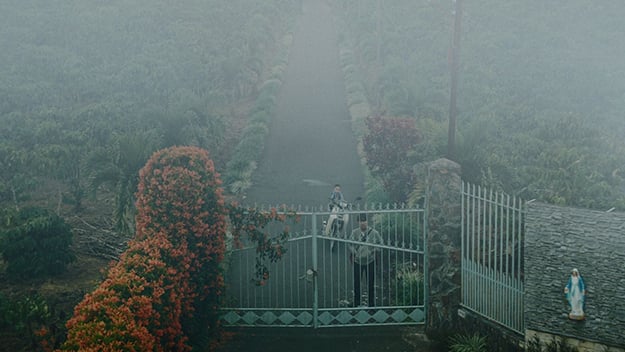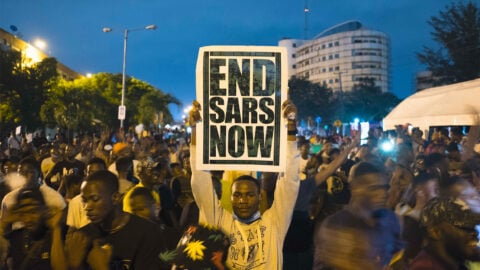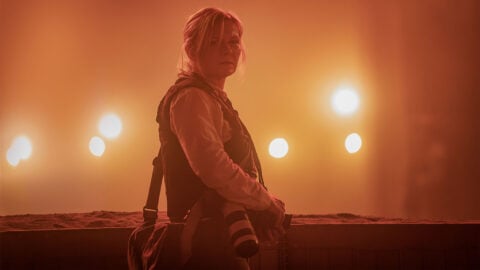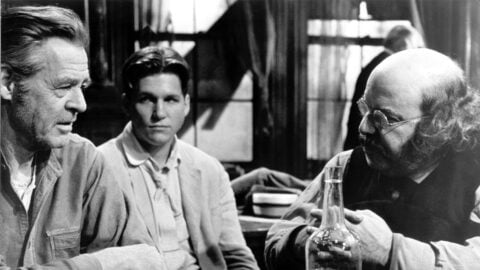Ordinary Magic
This article appeared in the January 19, 2024 edition of The Film Comment Letter, our free weekly newsletter featuring original film criticism and writing. Sign up for the Letter here.

Inside the Yellow Cocoon Shell (Phạm Thiên Ân, 2023)
The comparisons to Apichatpong Weerasethakul are inevitable, as are the words “otherworldly,” “poetic,” and “slow.” All of these have been used to describe Phạm Thiên Ân’s Inside the Yellow Cocoon Shell. While none of these descriptors are wrong, they nevertheless fail to grasp the film’s astonishing singularity. If we must begin with an analogue, let us consider Carl Theodor Dreyer’s Ordet (1955), another drama of faith played out in a remote village, close to wind, rain, and fog.
Actually, it takes Inside the Yellow Cocoon Shell a solid half hour to decamp to the Central Highlands of Vietnam, which is also when the film’s title card appears on screen. Before this, Thiên (Lê Phong Vũ), a young man, is seen in Saigon, eating at an outdoor restaurant in the film’s typically lengthy first shot. The camera pans carefully across a football match to Thiên’s table, where he sits with two friends. Everything in the frame is in focus, and it’s at first unclear where we should be looking—at the team mascot (a wolf with illuminated goggles) who wanders off the field? The young woman hawking beer? Though we hear a conversation about spirituality, it is difficult to identify who is speaking: within such a wide, busy frame, Thiên and his friends seem no more prominent than anything else. Suddenly, there is an off-screen crash. Without cutting, the camera pans to two scooters lying overturned in the road. Later, during an erotic massage at a spa, Thiên receives an urgent call which delivers news of his sister-in-law’s death.
Following the accident, Thiên takes his young nephew, Đạo (Nguyễn Thịnh), now without a guardian, to the rural Catholic community where he grew up—first for the funeral, then to search for his long-lost brother, the boy’s father. This homecoming, as many do, doubles as a spiritual quest. Already in that opening scene, faith seems to come more easily to others than to Thiên, like the friend who plans to travel to the countryside to find the meaning of life. “I want to believe, but I can’t,” Thiên admits. His urban existence is comfortable and dull, and his despondency suggests a quiet despair. Things change once Đạo enters his care. With Thiên suddenly flush with purpose, his spiritual struggle comes to the fore. Though he remains in the dark, now it seems there is a higher purpose at play. Gradually, Thiên starts to metamorphose—a process implied by the film’s title, a reference to the region’s artisanal silk production. But like the moths nestled in their fuzzy yellow cocoons, laid out on racks outside his family’s cottage, his transformation is largely kept from view.
The Ordet comparison is appropriate particularly because Phạm’s camera, like Dreyer’s, first accompanies characters, then moves past them and onto something else. Within the cramped quarters of the country home in Ordet, the panning camera indicates the limitations of each person’s perspective, measuring their distance to what they cannot—or do not—see. In Inside the Yellow Cocoon Shell, too, the camera’s attention extends past the ambits of its characters. Cinematographer Đinh Duy Hưng likes to propel his lens into deep space, pushing in on an actor at a nearly imperceptible crawl. He also makes masterful use of shallow focus. One remarkable shot starts out with only Thiên’s torso in view, the rainy city street blurry behind him. He dips below the frame, and when he returns, with a small bird in his palm, the image is startlingly crisp. In another scene, during a funeral service for Đạo’s mother, the power goes out and plunges the screen into near-darkness, though the mourners’ chanting proceeds unabated, like the candles burning on the altar.
This is faith as cinematic form: in every shot, Phạm compels us to dwell in the space just beyond what we see, or what we believe. Even if Thiên is not a believer, the way he sees, and the way we see him, keeps alive the possibility that something not yet known will appear, like a figure emerging from a thick fog. Perhaps this is why open doors and windows appear so frequently—these are invitations to the unknown, as when Đạo asks when his mother will return, and Thiên says he will leave the door open for her.
There are some shots in Inside the Yellow Cocoon Shell that seem too complex, too unlikely to be choreographed, but also too wondrous to be anything else. It’s a kind of magic, like the sleight-of-hand tricks Thiên performs for Đạo, which invoke another space where spirits can speak and the impossible can occur. Thiên is capable of cinematic trickery, too. In his work as a wedding videographer (a job that Phạm once held), we see him use an insert to conceal the appearance of a rude guest. Though he fully comprehends the subtleties of his craft, he also, at another point, laments that movies like It’s a Wonderful Life (1946) aren’t made anymore. What kind of films does he mean? Those where people get a second chance? Where miracles occur?
One night, on the verge of sleep, Đạo asks Thiên what faith is, and what it looks like. The priest had spoken of his mother’s strong faith at the funeral, and Đạo is curious, just as he is about heaven and dinosaurs. “It has no form,” Thiên says, before being interrupted by a misfiring alarm clock, whose glowing hands are all that can be seen in the otherwise pitch-black shot. He turns off the clock and tries again. “Have you ever lent your toys to a classmate?” he asks. Faith, he explains, is believing that the toy will come back.
Inside the Yellow Cocoon Shell does not guarantee that Thiên will find his faith. But it opens a door to its possibility. Its final act is accordingly ambiguous: as he journeys farther to find his brother, there’s no telling whether reality has stepped into a dream, or if something else is going on. But he does, in a sense, arrive at his destination. He comes to his brother’s home, where his sibling’s new wife holds an infant swaddled in a bright yellow blanket. She hands the child to Thiên, then goes off to fix lunch for her husband, who is at a worksite. What a good uncle he is, I thought while watching this scene. Wherever he may be in his spiritual quest, he never hesitates to provide care to the vulnerable creatures that get placed in his arms. Maybe faith is just this—a ready grace, or what remains after we release our expectations for what might come.
Genevieve Yue is an associate professor of culture and media at the New School and the author of Girl Head: Feminism and Film Materiality (Fordham University Press, 2020).







